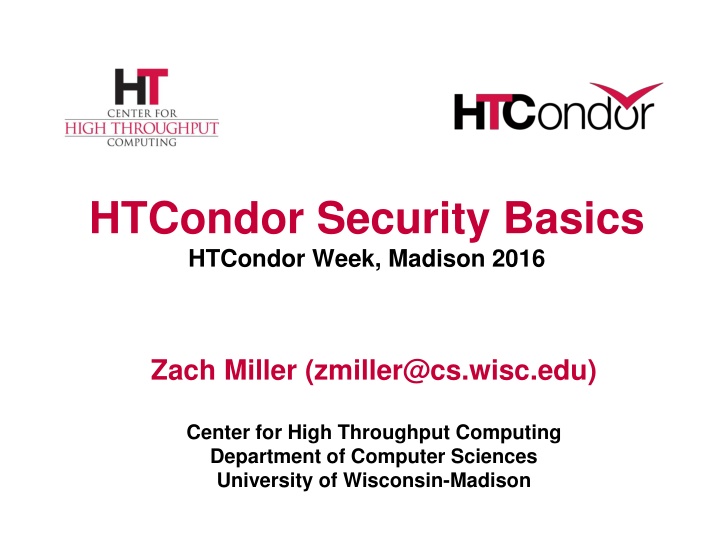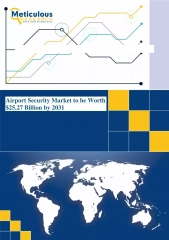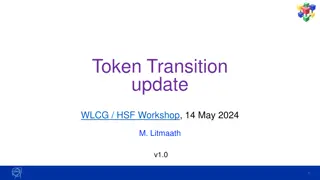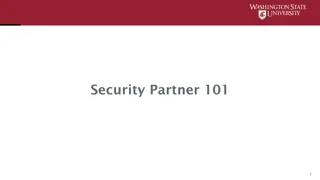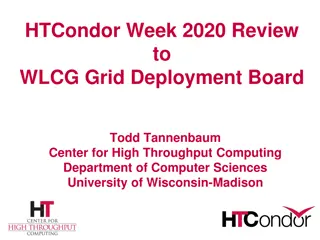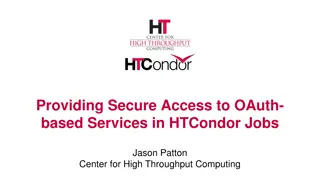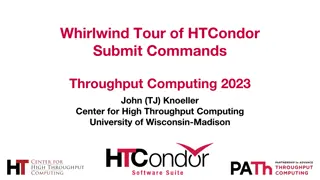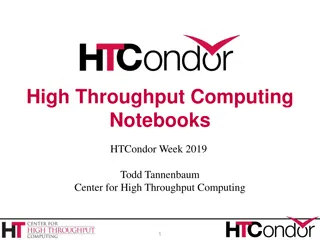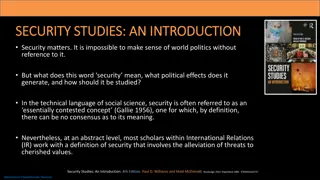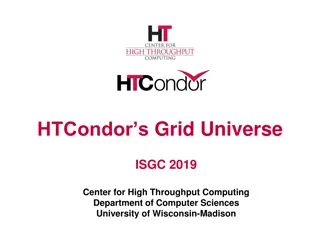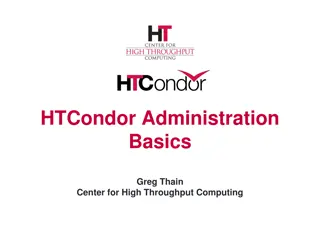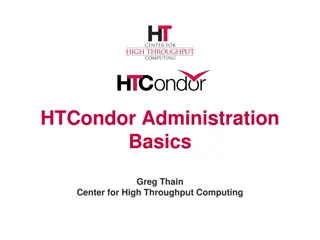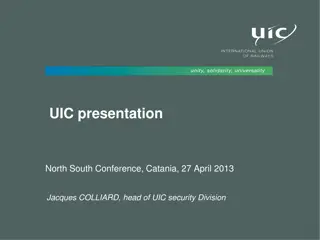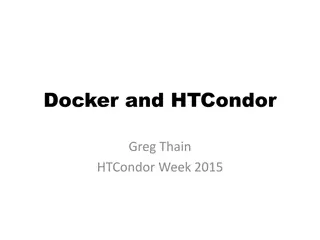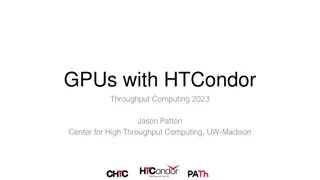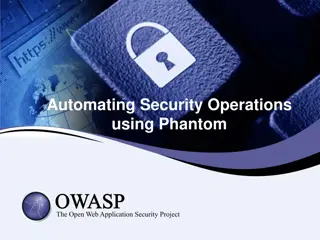HTCondor Security Basics
Explore the security concerns surrounding HTCondor, including threats from arbitrary code execution, the importance of authentication and authorization, and the need to only allow trusted entities access to your pool. Understand basic concepts of authentication and authorization in the context of HTCondor.
Download Presentation

Please find below an Image/Link to download the presentation.
The content on the website is provided AS IS for your information and personal use only. It may not be sold, licensed, or shared on other websites without obtaining consent from the author.If you encounter any issues during the download, it is possible that the publisher has removed the file from their server.
You are allowed to download the files provided on this website for personal or commercial use, subject to the condition that they are used lawfully. All files are the property of their respective owners.
The content on the website is provided AS IS for your information and personal use only. It may not be sold, licensed, or shared on other websites without obtaining consent from the author.
E N D
Presentation Transcript
HTCondor Security Basics HTCondor Week, Madison 2016 Zach Miller (zmiller@cs.wisc.edu) Center for High Throughput Computing Department of Computer Sciences University of Wisconsin-Madison
Overview What are the threats? Who do you trust? What are the mechanisms? Other security concerns? 2
Threats The purpose of HTCondor is to accept arbitrary code from users and run it on a large number of machines 3
Threats The purpose of HTCondor is to accept arbitrary code from users and run it on a large number of machines The purpose of a botnet is to take arbitrary code and run it on a large number of machines 4
Threats So what s the difference? You wish to prevent unauthorized access Ultimately, it just comes down to who can use your pool, and how they can use it. 5
Basic Concepts Who can use your pool is really two concepts: The Who is authentication The can use is authorization
Basic Concepts Authentication is finding out WHO some entity is. How is this done? Common methods: Present a secret that only you should know Perform some action that only you can do Present a credential that only you could have
Basic Concepts Authorization is deciding what someone is allowed to do. You must know who they are before you can decide this!
Basic Concepts I m using they pretty loosely here. They could be: A user A machine An agent/daemon/service
Basic Concepts In the context of an HTCondor pool: You want only machines that you trust to be in the pool You want only people you trust to submit jobs
Assumptions of Trust HTCondor relies on trusting the root user of a machine If this is compromised, all bets are off HTCondor daemons trust each other You need to trust your friendly HTCondor administrator 11
Assumptions of Trust How about users? HTCondor places some restrictions on users: zmiller cannot submit, remove, or manipulate jobs belonging to another user But bad users can still cause problems Running fork bomb: while(1) { fork() } Intentionally interfering with the system 12
Assumptions of Trust So, users are trusted to some degree Preventing every possible bad behavior makes the system too cumbersome for good users Security is always a balancing act with usability Decide how much you want to prevent versus punish 13
Restricting Users SUBMIT_REQUIREMENT allows the administrator to restrict what jobs are able to enter the queue Can be used to prevent users from lying about what groups they belong to: SUBMIT_REQUIREMENT_NAMES = GROUP1 SUBMIT_REQUIREMENT_GROUP1= (AcctGroup =!= group1 ) || (AcctGroup =?= group1 && (Owner== zmiller || Owner== tannenba )) SUBMIT_REQUIREMENT_GROUP1_REASON= User not in group1 14
Restricting Users SUBMIT_REQUIREMENT allows the administrator to restrict what jobs are able to enter the queue Can be used to allow only certain executable files, number of CPUs requested for a job, anything else that is part of the Job ClassAd 15
Authentication When users submit jobs, HTCondor authenticates them The HTCondor SCHEDD daemon now owns the jobs, and acts on their behalf.
Authentication So how can we trust the SCHEDD? Daemon-to-daemon authentication
Authentication For a secure pool, both users and HTCondor daemons must authenticate themselves HTCondor supports several mechanisms: File System Password Kerberos SSL GSI
Other Security Mechanisms In addition to authenticating network connections, you may also wish to use: Integrity Checks (MD5) Allows HTCondor to know if traffic has been tampered with Encryption (3DES, Blowfish) Allows HTCondor to transmit encrypted data so it cannot be spied on while in transit 19
Example Strong Configuration SEC_DEFAULT_AUTHENTICATION = REQUIRED SEC_DEFAULT_AUTHENTICATION_METHODS = Kerberos SEC_DEFAULT_ENCRYPTION = REQUIRED SEC_DEFAULT_INTEGRITY = REQUIRED 20
Security Negotiation When first contacting each other, HTCondor daemons have a short negotiation to find out which mechanisms are support and what features are required for the connection server client I want to submit a job You must authenticate w/ kerberos KERBEROS normal submit protocol 21
Security Negotiation Policy Reconciliation Example: CLIENT POLICY SEC_DEFAULT_ENCRYPTION = OPTIONAL SEC_DEFAULT_INTEGRITY = OPTIONAL SEC_DEFAULT_AUTHENTICATION = OPTIONAL SEC_DEFAULT_AUTHENTICATION_METHODS = FS, GSI, KERBEROS, SSL, PASSWORD SERVER POLICY SEC_DEFAULT_ENCRYPTION = REQUIRED SEC_DEFAULT_INTEGRITY = REQUIRED SEC_DEFAULT_AUTHENTICATION = REQUIRED SEC_DEFAULT_AUTHENTICATION_METHODS = SSL RECONCILED POLICY ENCRYPTION = YES INTEGRITY = YES AUTHENTICATION = YES METHODS = SSL
Security Configuration I m going to skip the detailed configuration of each particular security mechanism. Security is not one-size fits all If you are interested in details, please schedule some office hours with me to discuss. 23
Configuration Security Are your condor_config files secured? They should be owned and only modifiable by root. If you use a config directory, make sure only root can create files in it 24
Configuration Security HTCondor can allow configuration changes using a command-line tool: condor_config_val set Name Value However, this behavior is off by default and needs to be enabled on a case-by-case basis for each config parameter use carefully only if you really need it 25
HTCondor Privilege HTCondor typically runs as root Why? Impersonating users Process isolation Reading secure credentials When it isn t actively using root, it switches effective UID to another user ( condor ) 26
HTCondor Privilege HTCondor will never launch a user job as root. There is a circuit breaker at the lowest level to prevent it. If not using system credentials, the Central Manager can run without root priv Let s examine some different Startd configurations 27
StartD Configurations Startds have a few different options for running jobs: Run jobs as the submitting user Run jobs as the user nobody Allows jobs to interfere with one another Run jobs as a dedicated user per slot Keeps jobs running as a low-privilege user Isolates jobs from one another Makes it easy to clean up after a job 28
glexec Allows HTCondor daemons to be run without root privilege, yet running jobs can still assume the UID of the submitting user Uses GSI credentials to authenticate Very useful for glidein jobs 29
Encrypted File Transfer Even if that admin has not required encryption for all network connections, user jobs can specify per-file for both input and output if the files should be encrypted: Encrypt_Input_Files = file1, *.dat Encrypt_Output_Files = data.private 30
Encrypt Execute Directory If you are using Linux with ecryptfs installed, you can have HTCondor encrypt the execute directory on disk, offering extra protection of sensitive data. Can be enabled pool-wide by the admin: ENCRYPT_EXECUTE_DIRECTORY = True Per-job in the submit file: Encrypt_Execute_Directory = True 31
Vulnerabilities HTCondor has been assessed by an independent research group. That was many years ago. Another audit will be coming soon Our vulnerability reporting process is documented and vulnerability reports publicly available: http://research.cs.wisc.edu/htcondor/security/ 32
Questions? Schedule office hours this week Email the htcondor-users mailing list and if your question is security related I will (likely) respond Email me directly 33
